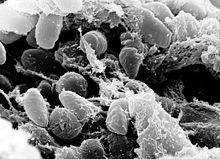
Back يرسينيا طاعونية Arabic يرسينيا طاعونيه ARZ Yersinia pestis AV Taun çöpü Azerbaijani Чумная палачка Byelorussian Yersinia pestis Bulgarian ইয়েরসিনিয়া পেস্টিস Bengali/Bangla Yersinia pestis Breton Yersinia pestis BS Yersinia pestis Catalan
| Yersinia pestis | |
|---|---|

| |
| A scanning electron micrograph depicting a mass of Yersinia pestis bacteria in the foregut of an infected flea | |
| Scientific classification | |
| Domain: | Bacteria |
| Phylum: | Pseudomonadota |
| Class: | Gammaproteobacteria |
| Order: | Enterobacterales |
| Family: | Yersiniaceae |
| Genus: | Yersinia |
| Species: | Y. pestis
|
| Binomial name | |
| Yersinia pestis (Lehmann & Neumann, 1896)
van Loghem, 1944 | |
| Synonyms | |
| |
Yersinia pestis (Y. pestis; formerly Pasteurella pestis) is a gram-negative, non-motile, coccobacillus bacterium without spores that is related to both Yersinia enterocolitica and Yersinia pseudotuberculosis, the pathogen from which Y. pestis evolved[1][2] and responsible for the Far East scarlet-like fever. It is a facultative anaerobic organism that can infect humans via the Oriental rat flea (Xenopsylla cheopis).[3] It causes the disease plague, which caused the Plague of Justinian and the Black Death, the deadliest pandemic in recorded history. Plague takes three main forms: pneumonic, septicemic, and bubonic. Yersinia pestis is a parasite of its host, the rat flea, which is also a parasite of rats, hence Y. pestis is a hyperparasite.
Y. pestis was discovered in 1894 by Alexandre Yersin, a Swiss/French physician and bacteriologist from the Pasteur Institute, during an epidemic of the plague in Hong Kong.[4][5] Yersin was a member of the Pasteur school of thought. Kitasato Shibasaburō, a Japanese bacteriologist who practised Koch's methodology, was also engaged at the time in finding the causative agent of the plague.[6] However, Yersin actually linked plague with a bacillus, initially named Pasteurella pestis; it was renamed Yersinia pestis in 1944.
Every year, between one thousand and two thousand cases of the plague are still reported to the World Health Organization.[7] With proper antibiotic treatment, the prognosis for victims is much better than before antibiotics were developed. A five- to six-fold increase in cases occurred in Asia during the time of the Vietnam War, possibly due to the disruption of ecosystems and closer proximity between people and animals. The plague is now commonly found in sub-Saharan Africa and Madagascar, areas that now account for over 95% of reported cases. The plague also has a detrimental effect on non-human mammals;[8] in the United States, these include the black-tailed prairie dog and the endangered black-footed ferret.
- ^ Achtman, Mark; Zurth, Kerstin; Morelli, Giovanna; Torrea, Gabriela; Guiyoule, Annie; Carniel, Elisabeth (1999-11-23). "Yersinia pestis, the cause of plague, is a recently emerged clone of Yersinia pseudotuberculosis". Proceedings of the National Academy of Sciences. 96 (24): 14043–14048. Bibcode:1999PNAS...9614043A. doi:10.1073/pnas.96.24.14043. ISSN 0027-8424. PMC 24187. PMID 10570195.
- ^ McNally, Alan; Thomson, Nicholas R.; Reuter, Sandra; Wren, Brendan W. (March 2016). "'Add, stir and reduce': Yersinia spp. as model bacteria for pathogen evolution" (PDF). Nature Reviews Microbiology. 14 (3): 177–190. doi:10.1038/nrmicro.2015.29. ISSN 1740-1534. PMID 26876035. S2CID 21267985.
- ^ Ryan, KJ; Ray, CG, eds. (2004). Sherris Medical Microbiology (4th ed.). McGraw Hill. pp. 484–88. ISBN 978-0-8385-8529-0.
- ^ Yersin, Alexandre (1894). "La peste bubonique à Hong-Kong". Annales de l'Institut Pasteur (in French). 8: 662–67.
- ^ Bockemühl, J (April 1994). "100 years after the discovery of the plague-causing agent—importance and veneration of Alexandre Yersin in Vietnam today". Immunitat und Infektion. 22 (2): 72–5. PMID 7959865.
- ^ Howard-Jones, N (1973). "Was Shibasaburo Kitasato the co-discoverer of the plague bacillus?". Perspectives in Biology and Medicine. 16 (2): 292–307. doi:10.1353/pbm.1973.0034. PMID 4570035. S2CID 31767623.
- ^ "Plague FAQ". CDC. 15 November 2021.
- ^ "The Plague", Centers for Disease Control and Prevention, October 2017
 This article incorporates text from this source, which is in the public domain.
This article incorporates text from this source, which is in the public domain.